How to maintain a septic tank and add a inspection / pump-out riser to a concrete septic tank.
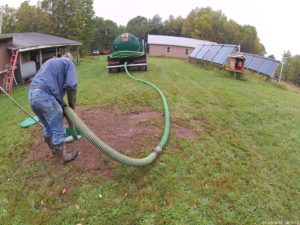
I have done some research and lived with septic systems all my life. I wanted to share what I have learned over my 50+ years.
How to maintain a septic tank. All septic tanks use bacteria to break down the waste that enters the septic tank.You should never pour any material down the drain that will kill the bacteria like solvents, large amounts of drain cleaners and bleach. The tank should be pumped every 3 to 5 years. Adding a riser will make it easier for the pumping company to service the tank and save you money.
If you read the rest of the article I will explain the septic tank in more detail.
How many different types of septic tanks are there?
There are many different types of septic tanks.
- Single compartment
- Double compartment
- Aeration systems (aerobic system)
- Plastic constructed
- Steel constructed
- Concrete constructed
- Fiberglass constructed
What are the basic parts of every septic system?
Every septic system to treat your household waste water has 4 basic parts
- Waste collection (toilet, sinks, house piping)
- Waste holding and processing (septic tank)
- Processed liquid removal (distribution pump or gravity fed box)
- Processed liquid disposal (leach field)
How does a septic tank work?
The waste you flush down the toilet goes into the tank and with the help of bacteria the waste is broken down. The process produces solids that sink to the bottom of the tank called sludge and the greases and soaps that are lighter than the water float to the top and form a layer of floating scum.
The septic tank works with the help of bacteria. There are 2 types of bacteria, aerobic and anaerobic.
Most septic tanks have the anaerobic bacteria that are helping break down the waste material. This is why most septic tanks are buried underground and do not require any fresh air.
If you have septic tank with a pump that is pumping fresh air into the septic tank then you have a aerobic system.
Both systems use the bacteria to break down the waste that enters the tank
What not to flush down the toilet
The only thing you should flush down the toilet is what comes out of the human body and toilet paper. You should never flush any plastics, diapers, wipes, paints, solvents, personal hygiene products or cat litter down the toilet. Here is a more detailed list of items from the EPA
What not to pour down the sink or tub/shower drain
Do not pour chemicals such as paint products, drain and floor cleaners, motor oil, antifreeze, and pesticides down the drain.
- Garbage disposals are not recommended for septic systems because of the large volumes of unprocessed organic waste and grease they produce. The bacteria can not process that much organic waste and will cost you. Here is a more detailed reason not to use a garbage disposal from King County Health Department https://www.kingcounty.gov/depts/health/environmental-health/piping/onsite-sewage-systems/maintenance/dos-and-donts.aspx
Can I drain my hot tub or pool into my septic system
You should not drain the hot tub or the pool water into the septic tank. There are two reasons not to drain these items into the tank.
- The chemicals in the pool and hot tub water are meant to keep the water clean by killing off bacteria.
- The large amounts of water added to the tank in a short period of time will dilute the bacteria and slow or stop their process of eating your waste.
What kind of maintenance does a septic tank require?
Maintenance of a septic tank is fairly simple, keep the bacteria happy and they will keep working for you. Don’t flush or pour anything down the drain that will make them sick and clean their home on a regular schedule
- aerobic systems require additional maintenance to clean screens and filters inside of the system. If you have one of these systems locate the owners manual and read it.
How often should a septic tank be pumped?
It is recommended that you have the septic tank pumped every 3-5 years EPA https://www.epa.gov/septic/how-care-your-septic-system
It depends on how many people you have in your house using the system and what you are depositing into the system. I have seen septic tanks that have not been pumped for 10 years or more and are still working, but, it seems that the tank plugs up at the most inconvenient times like during the holidays when you are using it the most.
Think of having your tank pumped like a insurance policy against the stress that is caused when the toilet stops working.
What is involved in pumping a septic tank?
The septic tank must be located and the service port needs to be exposed. The company you call to pump out the tank should be able to do this for you but at a cost. $100 – $500 estimated
Pumping out a septic tank is just like it sounds. A truck comes to your house and inserts a hose into the tank and removes the solids and sludge from the tank.
How much does it cost to pump a septic tank?
To have a company come pump out your tank will charge on the size of your tank, where you are located and the ease of access.
1000 gallon tank should cost $250 – $400
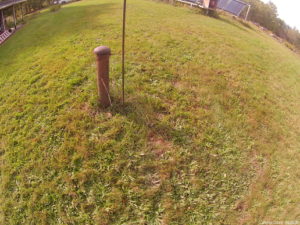
Where is my septic tank and how do I find it?
To find the septic tank you will need to look for some clues. Look for a vent pipe or a spot in the lawn that dies every summer that looks like a square or a circle. Good chance the tank is located there. You can use a metal rod as a probe to insert down in the ground to see if you can find the tank. This will give you a indication of the depth of the tank and where the edge is.
- Warning if you have a tank the top fails and you fall into the tank you could die
Check your building department for a set of plans if you don’t have any visible signs of a vent pipe.
If you know your neighbor you could ask them if they know.
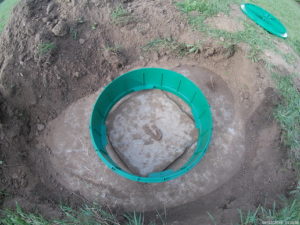
How many risers will I need and how big should they be?
You will not know how many risers you will need and how be they need to be until you uncover the top of the tank and see if you have a single or double compartment tank.
Single compartment (1) + any inspection ports as a option
Double compartment (2) + any inspection ports as a option
After your tank is uncovered then you will know how tall they will need to be.
How to install a riser on a concrete septic tank
- Expose the top of the tank and find the service port (this will make a mess of your lawn)
- Sweep off the soil from the tank top and see if the service port can be lifted out of the riser after it is installed
- If your riser is too short and needs to be a little taller you can raise it with some concrete bricks or form and pour some concrete. (I used some political signs ripped down to form the inside of the riser)
- If your riser is tall enough use some concrete or mortar around the riser to seat and hold it in place
- Replace the soil and reseed the lawn
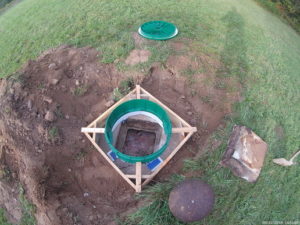
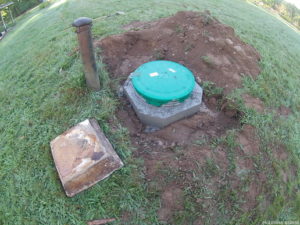
How much does a riser cost
The riser I installed cost around $100. That was for a 6 inch riser. A taller riser will cost a little more but is well worth the money.
How much money should a riser save
You should be able to recoup the cost of the riser on the very first pump out. (remember $100 – $500 cost to expose the service port)
The cost of lawn repairs (seed and fertilizer $15-$50) every time you want to service your tank.
What is your peace of mind valued at?
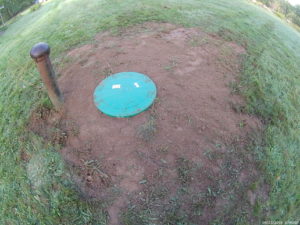
Let’s review what is involved with maintaining a septic tank
- Only flush human waste and toilet paper down the toilet
- Don’t use a garbage disposal
- Don’t pour anything down the drain that will harm the tank bacteria
- Have your septic tank pumped every 3-5 years
- Install a riser to save money on the pumping and lawn repairs
Another little tidbit about the leach field
- Do not park any auto on the leach field
- Do not build any buildings on the leach field
- Do not plant any trees, bushes or gardens on the leach field
- Do not cover your leach field with blacktop or concrete
Leach fields can become compacted from autos or buildings and stop working.
Leach fields can become clogged with roots and stop working.
If your leach field stops working it will need to be replaced and will cost $3000-$15000 as a estimate and will make a mess.
I hope this post has helped you out.
Gary 9/25/2018

